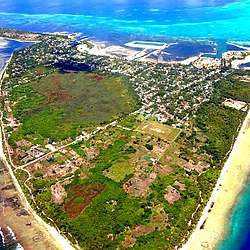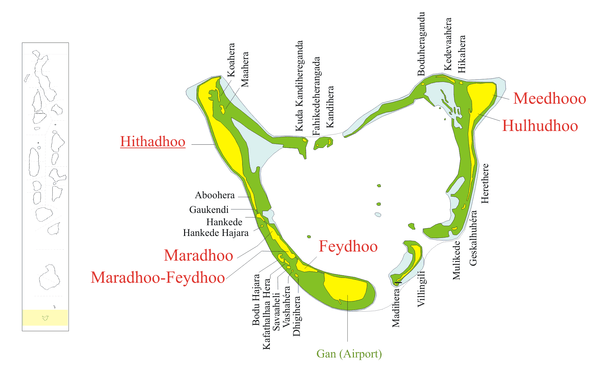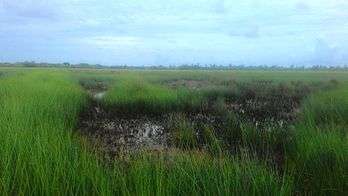Hulhumeedhoo
| Hulhumeedhoo | |
|---|---|
| Island | |
 Hulhumeedhoo Aerial view with Hulhudhoo on the left (south) and Meedhoo on the right (north). | |
 Hulhumeedhoo Location in Addu Atoll  Hulhumeedhoo Hulhumeedhoo (Maldives) | |
| Coordinates: 0°35′14″S 73°13′56″E / 0.587243°S 73.232281°ECoordinates: 0°35′14″S 73°13′56″E / 0.587243°S 73.232281°E | |
| Country | Maldives |
| Geographic atoll | Addu Atoll |
| Administrative atoll | Seenu Atoll |
| Distance to Malé | 530 km (330 mi) |
| Area | |
| • Total | 3.22 km2 (1.24 sq mi) |
| Population (2013) | |
| • Total | 6,492 |
| • Density | 2,000/km2 (5,200/sq mi) |
| Time zone | UTC+05:00 (MST) |
Hulhumeedhoo (Dhivehi: ހުޅުމީދޫ) or Hulhudhoo-Meedhoo is, though only 3.22 km² in area, a large island compared to other Maldivian islands. Being one of the largest islands in the archipelago, Hulhumeedhoo has roughly the land area of New York's Central Park. The island is located on the Northeastern point of Addu City. Although, the island was unified and brought under one administrative office when Addu Atoll was granted the status of a city, the island was previously divided into two separate administrative islands, Hulhudhoo and Meedhoo. A concept still kept alive by the inhabitants of Hulhudhoo and Meedhoo, and this has caused separation and rivalry between the two, especially the youths.
Facilities
Education
The island has multiple schools within Meedhoo and Hulhudhoo. Including Meedhoo's Shamsuddin School, Asriyya Preschool and Shareefee Preschool, and Hulhudhoo's Hulhudhoo School and Nasriyya Preschool. Seenu Atoll School is the only secondary school in Hulhumeedhoo.
History
The original settlers were Dhivehi people of Aryan origin. An Arab traveller called Yoosuf Naib introduced Islam to the island and built a place to worship Allah in the 12th century; this became the country's first mosque. The island has since been known as a centre of learning and Islamic religious education, famous for the scholars it has produced. [1]
The oldest cemetery in the Maldives, Kōgaṇṇu, is located in Meedhoo.
Landmarks
Hulhumeedhoo, being one of the oldest populated islands in the Maldives, is also home to ancient artifacts and remnants of World War II. Most of the ancient architectures are found at Kogannu Cemetery, the oldest cemetery in the country. It is the resting place of many notable people of past years, and ancient mosques and tombs. The island is also home to World War II era remnants like remains of coastal defense artillery and fortifications (Dhé Badi Dheythere), built on the island's eastern coast by the British based at RAF Gan during naval warfare with Axis powers.
Beaches
Hulhumeedhoo is not necessarily known for it's beaches and reefs, unlike many other islands and resorts in the Maldives. However, just like any other island in the archipelago, it is surrounded by a rich, turquoise lagoon. Some notable beaches of the island include, Eedhigamool beach, Kogannu beach, Kalhibih, and Héra Burikédéthan (Ismehelaa Hera). To the south of the island is, Canareef Island Resort, formerly Herathera - part of southern Hulhumeedhoo that was dredged and separated to build an island resort-. To the south is a similar island, Ismehelaa Hera, also separated from Hulhumeedhoo to build a resort. The resort is currently under construction.
Medhebandharo
Medhebandharo, also synonymously known as 'Fasgando', is the central harbour of the island. It is home to MPL Hulhumeedhoo Ferry Terminal and Hulhumeedhoo Fisheries Complex.
Hulhumeedhoo Kilhi
Hulhumeedhoo Kilhi or Mathikilhi or simply, Kilhi is a large marshy area which covers most of the land area of Hulhumeedhoo (it covers most of Meedhoo and Hulhudhoo). "Kilhi" usually means either Lake or Mangrove in Dhivehi language of Maldives. But here it refers to the large marshy area where hundreds (or thousands) of freshwater ponds are located. The ponds are known to have a few freshwater fish species found all year round.[2] The freshwater fish species found include, Greenstripe Barb (known by the locals as 'Fenfila'), another species known to the locals as Footumas, which literally means 'foot-long fish' even though they do not grow to that length) and a species of Swamp Eel.
Recently, the area has become more popular to the locals than ever, after the building of a pond called Mathikilhi Eco Garden. It has become a popular spot and landmark in the island.
The Hulhumeedhoo Kilhi is a common location of Marsh Wildfires in the island. The fires might be intentionally started by the locals or could be started naturally.

References
- ↑ "Koagannu cemetery, Meedhoo island, Addu Atoll". ExploGuide. Retrieved 2017-06-21.
- ↑ "Mathikilhi | Meedhoo.com". www.meedhoo.com. Retrieved 2017-06-21.